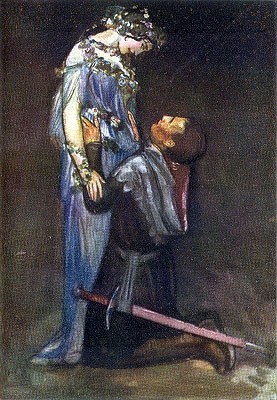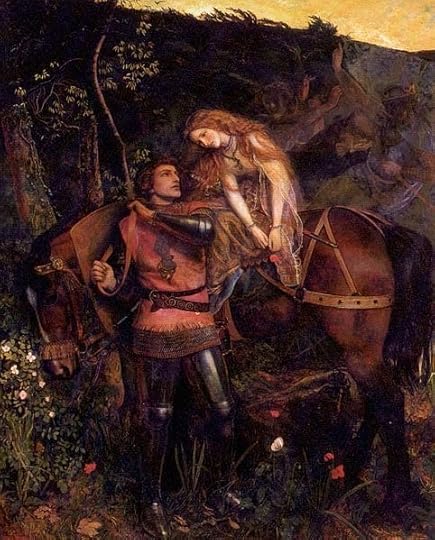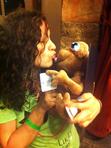Red Harvey's Blog, page 7
January 8, 2012
The Racial Implications of Herman Melville's "Benito Cereno"
 "An Attack on a Galleon"
"An Attack on a Galleon"Artist: Howard Pyle (1905)
Source: Wikimedia Commons
Herman Melville’s story Benito Cereno chronicles the American Captain Delano’s experience with the Spaniard cargo vessel, the San Dominick . Upon first boarding the vessel, Delano is surprised to see black slaves roaming the ship freely. He looks around for a captain, or any white man in authority, and he soon comes upon the Spaniard, Benito Cereno. Benito appears sickly, as his coughing fits continually interrupt his words. Constantly at Benito’s side is his black servant, Babo. To Delano’s eyes, Babo is the perfect servant. He is sweet, loyal, and Delano says of Babo to Benito, “I envy you such a friend; slave I cannot call him,” (Melville 3). Though there is plenty of strange activity on the boat that puts Delano off his guard (slaves sharpening hatchets, a black child’s violence that goes unpunished after he strikes a Spanish boy and draws blood), Delano lets his good nature convince him that everything is orderly enough on the San Dominick . What Delano is unaware of is the mutiny aboard the ship; the Africans are in charge of the Spaniards, a thought that Delano seems too naïve to comprehend. The mutineers have disguised their actions so as to stake a claim on Delano’s boat. Benito Cereno’s view of blacks is partly an antidote to racial stereotypes, while at the same time, it presents another stereotype. Captain Delano’s assumptions of the slaves aboard the San Dominick are reflective of past views with African-Americans; obedient, jovial, and ignorant. It took almost the entire story for Delano to realize that the slaves were capable of a great deal more than he had assumed possible for black men and women. Not only had the slaves murdered their owner (Benito’s friend Alexandro Aranda), but they had the intelligence to arrange the duplicitous meeting between “Captain” Benito and Captain Delano, driving the circumstances to their advantage. What I found to be a stereotype in the story was the fact that the slaves were the antagonist. In plenty of stories, the black man is seen as ‘bad’ or ‘wrong’, and usually in parallel to their dark skin. I did not like that the slaves were the antagonist, even though the story hinted at this possibility more than once (unbeknownst to the trusting Delano). An interesting note was the comparison of the savagery between the slaves and the white authorities: the slaves took Aranda’s body and made of it a sort of display, like a warning on the prow of the ship (a skeleton). And yes, that seems barbaric and disgusting, but when Babo is tried and hanged, his head is put on a pike for display in the city of Lima, another warning of a different sort, but not really different at all. Perhaps a point Melville was trying to convince the reader of is that, despite race, men are very alike in terms of behavior, as both races in the novel are capable of great violence and great intelligence.
Published on January 08, 2012 07:17
December 2, 2011
Morris Sweetkind and "Poetry in a Scientific World"
Morris Sweetkind’s article “Poetry in a Scientific World” offers a different view on why poetry is still relevant to a society engulfed by technological advances.
 Author: John Forster, 1678.
Author: John Forster, 1678.
Source: Library of Congress via
Wikimedia CommonsSome of Sweetkind’s main points include the importance of poetry in curriculum. While it is true that many students do not see poets at the helm of society (primarily it is politicians and engineers), poetry has a place in education because it can teach things that science cannot. Sweetkind outlines the four components of a healthy individual that the writer Matthew Arnold once spoke of: (1) the power of conduct; (2) the power of intellect and knowledge; (3) the power of beauty; (4) the power of social life and manners
In excluding poetry in the sole pursuit of scientific query, Sweetkind believes that a person is only reaching one-fourth of their potential (the power of intellect and knowledge), (360). Even with all the knowledge of science at his or her fingertips, there is a still a question as to how it can be applied to the world. Will the student use the knowledge they have to judiciously better the world, or will they use it irresponsibly to destroy the world?
Though Sweetkind’s essay is written in the 1970’s, the points he makes about the division of poetry and science are still relevant. Our society today is still heavily centered around technology and advancement. It seems as if everyone has a Smartphone attached to their finger. Book sales have declined and everything is becoming digitized. Still, a complete digitalization of things like books, movies and music is not all bad. Inventions like Amazon’s Kindle have encouraged reading, and Kindles are even being used in some school classrooms.Sweetkind spoke of technology as being desensitizing and I partly agree with him. Technology is efficient and convenient, but, as Sweetkind suggests, at what cost?
Works Cited:
Sweetkind, Morris. “Poetry in a Scientific World”. The English Journal, 59.3 (1970): 359-36. JSTOR. Web. 3 October 2011.
 Author: John Forster, 1678.
Author: John Forster, 1678.Source: Library of Congress via
Wikimedia CommonsSome of Sweetkind’s main points include the importance of poetry in curriculum. While it is true that many students do not see poets at the helm of society (primarily it is politicians and engineers), poetry has a place in education because it can teach things that science cannot. Sweetkind outlines the four components of a healthy individual that the writer Matthew Arnold once spoke of: (1) the power of conduct; (2) the power of intellect and knowledge; (3) the power of beauty; (4) the power of social life and manners
In excluding poetry in the sole pursuit of scientific query, Sweetkind believes that a person is only reaching one-fourth of their potential (the power of intellect and knowledge), (360). Even with all the knowledge of science at his or her fingertips, there is a still a question as to how it can be applied to the world. Will the student use the knowledge they have to judiciously better the world, or will they use it irresponsibly to destroy the world?
Though Sweetkind’s essay is written in the 1970’s, the points he makes about the division of poetry and science are still relevant. Our society today is still heavily centered around technology and advancement. It seems as if everyone has a Smartphone attached to their finger. Book sales have declined and everything is becoming digitized. Still, a complete digitalization of things like books, movies and music is not all bad. Inventions like Amazon’s Kindle have encouraged reading, and Kindles are even being used in some school classrooms.Sweetkind spoke of technology as being desensitizing and I partly agree with him. Technology is efficient and convenient, but, as Sweetkind suggests, at what cost?
Works Cited:
Sweetkind, Morris. “Poetry in a Scientific World”. The English Journal, 59.3 (1970): 359-36. JSTOR. Web. 3 October 2011.
Published on December 02, 2011 09:21
September 6, 2011
Moral Themes in "The Fellowship of the Ring"
 The hand of Sauron, wearing the One Ring. 2005,
The hand of Sauron, wearing the One Ring. 2005, Author Katie Tegtmeyer.
Through the world of books, a reader can experience many things without leaving the comfort of their favorite chair. A book can take a reader to Phuket, Bath, or St. Louis. While reading, a person can travel the world, meet new people, and imagine what it would be like to skydive or engage in espionage. Literature is far more important for another reason; literature can guide a reader’s moral compass. Since long ago when fables and parafables were popular, literature and ethics have been synonymous. Stories like “The Tortoise and the Hare” and “Prodigal Son” explain to the reader life lessons in a simplistic way. Somewhere along the years, literature and ethics began to part ways.
According to Adia Mendelson-Maoz, the divide between ethics and literature began in the times of Aristotle and Plato, continuing on through the first half of the twentieth century, (112). Mendelson-Maoz takes a quote from writer Oscar Wilde in his preface to The Picture of Dorian Gray, which sums up the feelings felt in the academic community about linking literature and ethics: “There is no such thing as a moral or immoral book. Books are well written, or badly written. That is all.”
Times have changed yet again, and the parallel concerning literature and ethics has seen a revival. James Adamson writes, “Although literature and ethics have different methods, strategies, and goals, they are both forms of writing which deal with human lives; they both can be viewed as models of moral attention” (92–93). There are many books that include ethics or morals as part of the story. In Stephen King’s novella The Body, the reader understands why the lead character Gordy feels it best to leave the body ‘unclaimed’ by either group; it is a question of what is really right and what is really wrong. Flashfoward by Robert J. Sawyer takes the reader through a world where fate does not govern all. Sawyer’s story illustrates to the reader that the future can be changed, based on our own actions and choices. Another perfect example of moral themes found in literature would be The Lord of the Rings (or LOTR). J.R.R Tolkien’s three story arc is set in a fantastical world beyond the imagination of many, and yet, he still manages to convey moral concepts in each part of LOTR, many of them found in The Fellowship of the Ring.
Part one of LOTR, The Fellowship of the Ring, features many themes. None are as present as the theme of pity and mercy in the face of death. While Gandalf the Grey wizard is explaining to Frodo Baggins the origins of how the Ring came to rest in his fate, he describes the story of the creature Gollum. Gollum had the ring for 500 years, but the Ring chose to leave him. By chance, Bilbo Baggins finds the ring in Gollum’s cave and takes it for his own. Bilbo had the chance then to kill Gollum, who was obviously a deranged and dangerous creature. Frodo wonders aloud at why he did not, and he says to Gandalf, “What am I to do? What a pity that Bilbo did not stab that vile creature, when he had the chance!" Those words spark a conversation between the two that is as follows:
 Joe Sofranko as Frodo, 2007
Joe Sofranko as Frodo, 2007Theguyinblue “Pity? It was Pity that stayed his hand. Pity, and Mercy: not to strike without need. And he has been well rewarded, Frodo. Be sure that he took so little hurt from the evil, and escaped in the end because he began his ownership of the Ring so. With Pity.” “I am sorry,” said Frodo. “But I am frightened; and I do not feel any pity for Gollum.” “You have not seen him,” Gandalf broke in. “No, and I don’t want to,” said Frodo. “I can’t understand you […] after he did all those horrible deeds […], he deserves death.” “Deserves it! I daresay he does. Many that live deserve death. And some that die deserve life. Can you give it to them? Then do not be too eager to deal out death in judgment. For even the very wise cannot see all ends. I have not much hope that Gollum can be cured before he dies, but there is a chance of it. And he is bound up with the fate of the Ring. My heart tells me that he has some party to play yet, for good or ill, before the end; and when that comes, the pity of Bilbo may rule the fate of many---yours not least.”-(Tolkien, 68-69).
Gandalf’s words suggest that a higher power may be at work, as he puts it “for good or ill". Even though Gollum is a reprehensible creature (a thief, traitor, and murderer), to decide his death or the death of others is not necessarily up to one person. Judgment in death must never be decided lightly, or (maybe as Tolkien believed) by human beings at all.
One of the recurring moral themes in The Fellowship of the Ring is the idea of temptation, and corruption from power. Several characters are offered the chance to have the Ring for themselves and do with it what they want: Gandalf, Elrond, Tom Bombadil, Aragorn, and Galadriel. Though they may desire it, they do not accept the Ring because they know it has only the power to destroy. Elrond is a very old elf, and saw the destruction Sauron wrought with the Ring during the Great War. For this reason, and others, he does not take the Ring. Men are easily drawn in by the power of the Ring; Aragorn almost could not resist Frodo’s offer to take the Ring from him. Aragorn is a hero of the story and displays more moral fiber than most, therefore he decides rather easily not to take the Ring.
 Depiction of "Rivendell": Jardim Tropical Monte Palace in
Depiction of "Rivendell": Jardim Tropical Monte Palace in Funchal, Madeira. 2009, Author Tim Walker. One of the members of the Fellowship has a harder time withstanding the call of the Ring: Boromir of Gondor. From the very beginning of the quest, he thinks the Ring can be used as an instrument of good. He believes that it might save his kingdom, Gondor, from ruin. At the end of The Fellowship of the Ring, he tries to physically take the Ring from Frodo. But Frodo is able to escape. Later, Boromir is asked to help the two Halflings Merry and Pippin from a group of Uruk-hai. Perhaps because it was meant to be, or perhaps because Tolkien wanted to show that giving into temptation brings dire consequences, Boromir is slain while defending Merry and Pippin. One could argue that he sought repentance in trying to save the two Hobbits. Either way, Boromir’s moral compass led him astray and with his death, he may have been able to find redemption.
The Fellowship of the Ring is full of moral themes, such as pity and mercy, judgment in death, temptation, and redemption. However, LOTR is not the only story worth analyzing for ties of literature and moral themes. Ford Jameson believes that “every text contains traces of social, political, and ethical issues, whether in an overt form, or unconsciously.” Whether delving into a romance novel or science fiction, elements of ethics are bound to be identified. There does not have to be a separation of between ethics and literature. Ethics and literature naturally go together, and that is not a bad thing. Literature is a kaleidoscope of knowledge, rife with teachings about every facet of life. Ethics has found a niche in literature, whether some agree with its place or not.
Works CitedAdamson, James. Against Tidiness: Literature and/Versus Moral Philosophy. Cambridge: Cambridge University Press, 1998. Print.
Jameson, Ford. The Political Unconscious. Ithaca, New York: Cornell University Press, 1981. Print.
Mendelson-Maoz, Adia. “Ethics and Literature: Introduction”. Philosophia 35 (2007)
Published on September 06, 2011 13:46
July 28, 2011
A Summary, Analysis, and Opinion of "La Belle Dame Sans Merci" by John Keats
 "La Belle Dame Sans Merci" by Frank Bernard Dicksee.
"La Belle Dame Sans Merci" by Frank Bernard Dicksee.One of the most famous poems by John Keats would be: "La Belle Dame Sans Merci" (meaning "the beautiful woman without mercy" in old French). It is not exactly a short poem, but twelve stanzas is not that long, either. There is an alternate manuscript version, but I chose the 1819 published version to dissect. I chose it because of the supernatural elements suggested in the poem, alluding to a 'farey', her powers, and her merciless disposal of men. A few relevant stanzas are:
Oh what can ail thee, knight-at-arms,
Alone and palely loitering?
The sedge has withered from the lake, And no birds sing.
I met a lady in the meads,
Full beautiful - a faery's child,
Her hair was long, her foot was light, And her eyes were wild.
I set her on my pacing steed,
And nothing else saw all day long,
For sidelong would she bend, and sing A faery's song. -(English, 2011).
To begin with, a paragraph of a summary of the poem reads:
 "La Belle Dame Sans Merci" by Robert Anning Bell“La Belle Dame sans Merci,” written in 1819 and published the next year in a form slightly different from the one here, depicts a knight-at-arms who has been seduced and abandoned by a capricious fairy. Told in the form of a dialogue, the poem recounts the experience of loving dangerously and fully, of remaining loyal to that love despite warnings to the contrary, and of suffering the living death of one who has glimpsed immortality," (enotes, 2011).
"La Belle Dame Sans Merci" by Robert Anning Bell“La Belle Dame sans Merci,” written in 1819 and published the next year in a form slightly different from the one here, depicts a knight-at-arms who has been seduced and abandoned by a capricious fairy. Told in the form of a dialogue, the poem recounts the experience of loving dangerously and fully, of remaining loyal to that love despite warnings to the contrary, and of suffering the living death of one who has glimpsed immortality," (enotes, 2011). This poem could be interpreted in a myriad of ways. There are some people who think that the fairy exists only in the imagination and others who believe her to be equitable to a siren, luring men in to become her emotional slaves. One analysis takes a different route: "The references to "faery" and "elfin" suggest enchantment or imagination. Her "sweet moan" and "song" represent art inspired by imagination. The lady, symbolizing imagination, takes him to an ideal world. The knight becomes enraptured by or totally absorbed in the pleasures of the imagination--the delicious foods, her song, her beauty, her love or favor ("and nothing else saw all day long"). But the imagination or visionary experience is fleeting; the human being cannot live in this realm, a fact which the dreamer chooses to ignore. The knight's refusal to let go of the joys of the imagination destroys his life in the real world," (Melani, 2010).
In poetry analysis, it may be hard to differ opinion from actual analysis. While searching articles and websites online, I was struck by how similar they sound. After reading a few, I was able to tell them apart more easily. Here is one example of an opinion about Keats' poem:
 "La Belle Dame Sans Merci" by Arthur Hugues.“La Belle Dame sans Merci” is one of Keats’s most beloved poems and one of the few important works that seems to evade the kind of critical argumentation invoked by the odes and long poems. Typical of critics’ magnanimity toward the ballad is T. Hall Caine’s 1882 assessment of the poem as the “loveliest [Keats] gave us.” He writes that the ballad is “wholly simple and direct, and informed throughout by a reposeful strength. In all the qualities that rule and shape poetry into unity of form, this little work strides, perhaps, leagues in advance of ‘Endymion,’” (enotes, 2011).
"La Belle Dame Sans Merci" by Arthur Hugues.“La Belle Dame sans Merci” is one of Keats’s most beloved poems and one of the few important works that seems to evade the kind of critical argumentation invoked by the odes and long poems. Typical of critics’ magnanimity toward the ballad is T. Hall Caine’s 1882 assessment of the poem as the “loveliest [Keats] gave us.” He writes that the ballad is “wholly simple and direct, and informed throughout by a reposeful strength. In all the qualities that rule and shape poetry into unity of form, this little work strides, perhaps, leagues in advance of ‘Endymion,’” (enotes, 2011). One can tell that it is an opinion because of the use of words like "beloved" and "important". The author believes the poem to be a beloved and important work, and that is all based on the author's own opinions. This opinion offers little in the way of new information or analysis.
References:
English. (2011). La belle dame sans merci. Retrieved on July 25, 2011 from http://englishhistory.net/keats/poetry/labelledamesansmerci.html
Enotes. (2011). La belle dame sans merci: summary. Retrieved on July 25, 2011 from http://www.enotes.com/la-belle-dame-sans-meri/summary
Melani, L. (2010, September 27). The significance of 'la belle dame sans merci'. Retrieved on July 25, 2011 from http://academic.brooklyn.cuny.edu/eng...
Published on July 28, 2011 09:12



